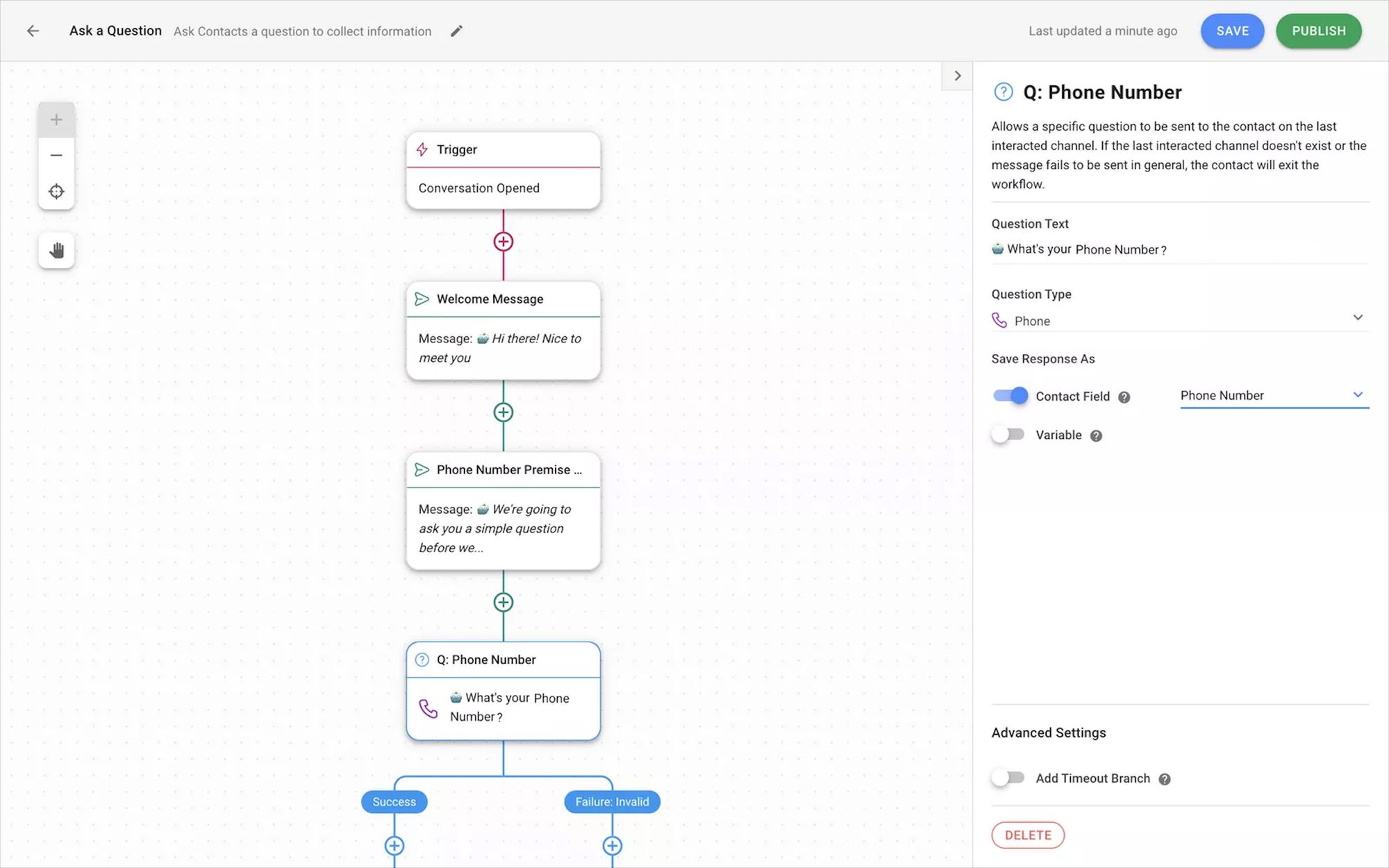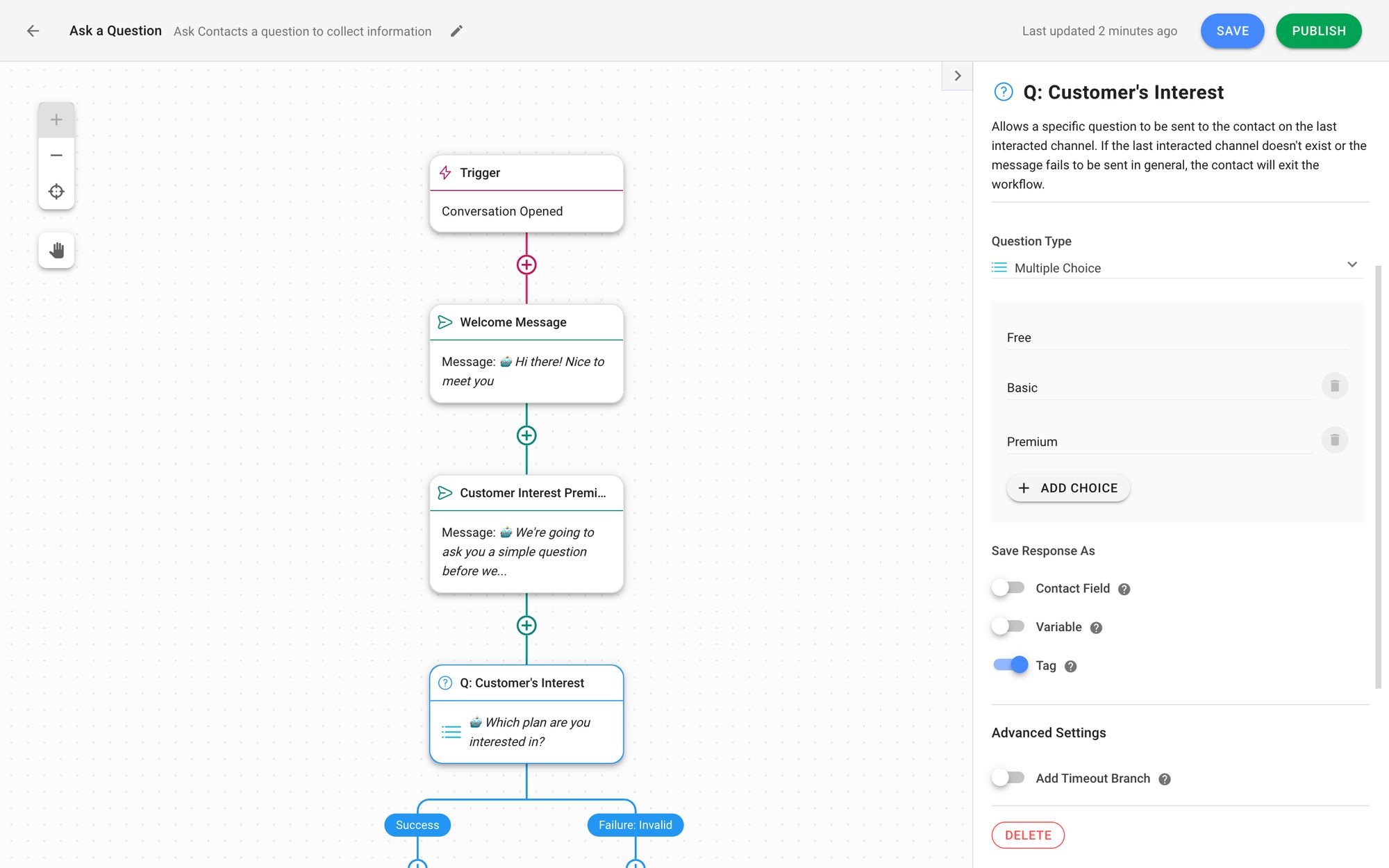
Looking to use a question bot to collect customers’ information? Ask them a question with Workflows! In this article, we will discuss how to ask customers open-ended or specific questions. We will also show you how to set up automated data capture by saving the responses as Contact Fields or Variables. Plus, you will learn how to use the Validation and Timeout Branches to handle invalid responses by customers.
Ask a Question: An Introduction to Question Bot
Ask a Question is a Workflow Step that lets you collect information from customers using a question bot. Based on the information collected, you can route Contacts to someone who can solve their problem through Branches.
To manage customers’ expectations, you should make it obvious that they are chatting with a question bot. A simple way to do so is by adding a robot emoji at the start of every question.
Turn customer conversations into business growth with respond.io. ✨
Manage calls, chats and emails in one place!
How to Ask Customers a Question
In Workflows, you can ask open-ended questions or specific questions which require customers to enter their answers in a certain format. Specific question types include Phone Number, Email, Website, and Multiple Choice Questions.
Ask Customers an Open-Ended Question
Open-Ended Questions allow for a longer response and therefore are useful for collecting qualitative data and understanding customers’ issues. They provide detailed insight into the business problems customers are facing, empowering businesses to deliver better customer service.

We recommend saving the answer to an open-ended question as a Variable. Subsequently, the Variable can be added to an internal Comment for Managers, appended to a Google Sheet for analysis or sent to an external CRM via an HTTP Request.
Remember, if customers reply to a question with multiple messages, only the first response will be recorded by the question bot. To ensure that the full response is recorded, encourage customers to limit their answers to one sentence.
Phone Number Question Bot: Ask for a Phone Number
Phone Number Questions are designed to collect phone numbers from customers. An acceptable phone number would contain the country and area codes.

You should save the phone number received in the Phone Number field. If you have a phone number-enabled channel like WhatsApp or SMS connected to the platform, you can reach out to your customers right away by sending them the first message from the Channels tab.
Email Question Bot: Ask for an Email Address
Email Questions are perfect for collecting customers’ email addresses. The Email Question bot only accepts a valid email address. An example of a valid email address would be user@email.com.

Once you have gotten your customer’s emails, send an HTTP Request to reach out to your CRM and retrieve the rest of the contact profile. If you have connected your email account to the platform, you would be able to reach out to customers via email from the Channels tab.
Website Question Bot: Ask for a Website
In sales, websites are a useful resource for qualifying leads. A Website Question bot is useful for requesting customers’ websites. It requires customers to provide a valid URL, with or without the http:// prefix.

To save the website provided for future reference, you’ll need to create a custom Contact Field. For lead qualification purposes, use HTTP Request to call a data enrichment service like Clearbit.
Ask Customers a Multiple Choice Question
Multiple Choice Questions are a handy way to limit responses to a predetermined list of options. In Multiple Choice Questions, customers are required to respond with one of the options.
You can create up to 10 options in a Multiple Choice Question. Each option is limited to 20 characters, which is the maximum length allowed on Channels like Facebook Messenger.

What’s next after customers respond? It depends on the purpose of your Multiple Choice Question bot. If your question helps to complete the Contact Profile, store the response in a Contact Field. If you are looking to understand customers' interests with your question, save the answers as Tags and use them for sending targeted broadcasts.
Want to ask further questions or route customers to the correct agent based on their response? Simply save the selected option as a Variable. Now that you know how to use a question bot, let’s discuss the ways to handle invalid or missing responses.
Handling Invalid or Missing Responses
In a real-life situation, Contacts may not provide the response you were looking for. Some of them may not respond at all. There are two ways to handle invalid or missing responses- use the Validation branch or the Timeout branch.
Use the Validation Branch
The Validation Branch helps you assist Contacts who provide an invalid response. When customers provide an answer that does not fit the necessary response type, they will arrive at the branch.

In the Validation Branch, you can let Contacts know how to correct their answer and ask the question again. If you are looking to generate sales or support high-value customers, assign the Contact who provided the invalid response to a live agent. However, if you view customer support as a cost center, simply close the Conversation with the Contact.
Use the Timeout Branch
The Timeout Branch is ideal for dealing with customers who don’t respond to your question. Contacts will enter the branch if no response is received within the specified timeframe.

If customer support is a competitive advantage of your company, encourage your Contacts to respond quickly, say, within 5 minutes. Then, ask the question again. Companies that treat customer support as a cost center should close the Conversation with someone who failed to respond.
And that’s everything you need to know about the Ask a Question Step. Respond.io’s Workflows help you request customer data effortlessly with a question bot. You can then store the responses through automated data capture and use them to make better decisions.
Turn customer conversations into business growth with respond.io. ✨
Manage calls, chats and emails in one place!
Further Reading
If you would like to learn more about Workflows, check out these articles:






































 Electronics
Electronics Fashion & Apparel
Fashion & Apparel Furniture
Furniture Jewelry and Watches
Jewelry and Watches
 Afterschool Activities
Afterschool Activities Sport & Fitness
Sport & Fitness
 Beauty Center
Beauty Center Dental Clinic
Dental Clinic Medical Clinic
Medical Clinic
 Home Cleaning & Maid Services
Home Cleaning & Maid Services Photography & Videography
Photography & Videography
 Car Dealership
Car Dealership
 Travel Agency & Tour Operator
Travel Agency & Tour Operator




